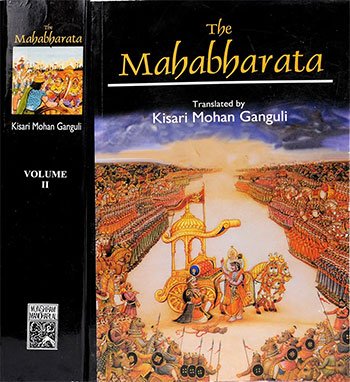Section C - Battle Formation in Epic War: Bhishma vs Pandavas
Book index: Mahabharata (English)
This page contains a summary of the Mahabharata Section C including examples of moral lessons in daily life. The Maha-Bharata is one of the largest epics ever written containing roughly 100,000 Sanskrit verses. It deals with the legendary history of ancient India and contains a large number of interwoven tales.
Short summary of the chapter:
The story begins with Bhishma leading the Kaurava army in a mighty array, ready for battle. On the other side, Yudhishthira, Bhimasena, and the Pandava forces stand at the forefront of their array, prepared to face the Kauravas. The two armies clash with loud cries and the earth trembles with the intensity of their battle. The atmosphere is filled with the sounds of conches, drums, and roaring warriors, creating a scene of chaos and impending doom.
As the battle intensifies, the warriors on both sides engage in fierce combat, with the Pandavas led by Bhima charging towards Bhishma and the Kaurava army. The clash of swords, the clang of armor, and the roars of warriors fill the air, creating a terrifying atmosphere on the battlefield. The Sun itself seems to dim, ominous signs appear in the sky, and even the animals are disturbed, with tears falling from their eyes and eerie cries filling the air. The battlefield becomes a scene of devastation and chaos, with death and destruction looming large.
Amidst the chaos, the forces of both sides continue to fight fiercely, with neither willing to back down. The clash of arms and the shouts of warriors blend into a deafening cacophony, shaking the very foundations of the earth. The intensity of the battle is reflected in the trembling of the vast armies, as kings, elephants, and steeds collide in a savage melee. The scene is one of utter chaos and destruction, with no respite in sight as the two sides wage war relentlessly.
The battle rages on, with no sign of either side gaining a clear advantage, as the warriors fight with all their might for their respective causes. The clash of arms and the cries of the combatants fill the air, as the battlefield becomes a harrowing spectacle of death and destruction. Amidst the chaos and carnage, the fate of the war hangs in the balance, as the forces of good and evil collide in a brutal struggle for supremacy. The outcome of this epic battle will determine the future of the kingdoms involved, with victory and defeat hanging in the balance as the warriors fight on with unyielding determination.
In the midst of the fierce battle, both sides show no signs of backing down as they continue to clash with unfaltering determination. The warriors, led by their mighty leaders, fight bravely on the battlefield, with the fate of kingdoms at stake. The intense conflict and the chaos of war envelop the battlefield, as the sounds of battle and the cries of the combatants echo through the air. The outcome of this epic confrontation remains uncertain, as the forces of good and evil wage a bloody struggle for supremacy in a battle that will be remembered for generations to come.
Full English translation:
This page is merely a summary which is automatically generated. If you are looking for authentic sources such as the Sanskrit text or the Full English translation of Mahabharata Section C - Battle Formation in Epic War: Bhishma vs Pandavas, have a look at the following articles:
Section C, online text
English translation by Kisari Mohan Ganguli.
Read this and other chapters online.
Mahabharata (English Summary)
by Kisari Mohan Ganguli | ISBN-10: 8121505933
Buy the latest edition:
FAQ of Mahabharata, Section C:
What was the formation of the Kaurava army in the battle?
The Kaurava army was led by Bhishma and included powerful warriors like Drona, Sudakshina, and Bhurisravas in different wings. Bhishma positioned himself in the front line.
Who led the Pandava army in the battle against the Kauravas?
Yudhishthira, Bhimasena, Nakula, Sahadeva, Arjuna, and other warriors formed the Pandava army. They were clad in mail and positioned themselves to face the Kauravas, led by Bhishma.
Daily life: Battle Formation in Epic War: Bhishma vs Pandavas:
The story vividly describes the heated and intense moments before a great battle, highlighting the strategic positioning of warriors, the rallying of troops, and the emotional and environmental reactions to the impending conflict. To apply the essence of this narrative to daily life, one could focus on the importance of preparation and strategy. Just as the commanders organized their forces thoughtfully, aligning their strongest warriors where they were most needed, in daily challenges, planning and positioning resources effectively can lead to better outcomes.
The story also emphasizes the power of unity and leadership. The leaders stood at the forefront, inspiring their troops and facing the adversities head-on, showcasing how leading by example can galvanize a team or family to confront difficulties with confidence. Furthermore, the intense atmospheric changes and the reaction of animals to the battle serve as a metaphor for being aware of the signs of change and turmoil in one's environment and preparing oneself mentally and physically for the challenges ahead.
Finally, the narrative demonstrates that amidst the chaos, keeping a clear head and focusing on the goal can guide one through the toughest times, resembling the way soldiers had to focus amid the overwhelming noises of war. Drawing from this, in daily life, remaining focused amid distractions and maintaining one's resilience can lead to overcoming obstacles and achieving set objectives.
